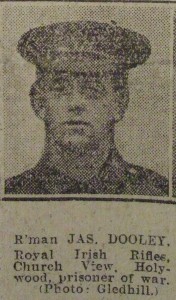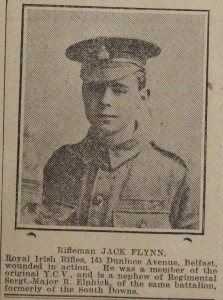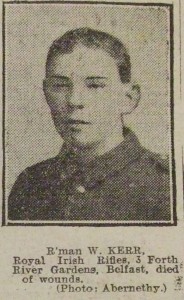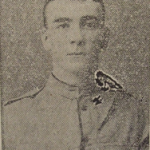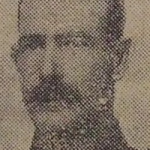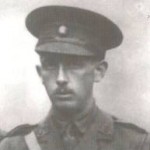History Hub Ulster friend John McCormick writes for us today on Captain J.S. Davidson, Director and General Manager of Davidson & Co. Ltd.
John is page admin of the Facebook page 36th (Ulster) Division For God and Ulster. He describes his page as “A page for anyone with a historical interest in the original: Ulster Unionist 1912; Ulster Volunteer Force 1913; 36th (Ulster) Division; Great War 1914 to 1919 and the Orange Order & the Great War.
FELL ON ANCRE SLOPES
___________________
LATE CAPT. DAVIDSON
___________________
KEEPING HIS MEMORY GREEN,
___________________
MEMORIAL TABLET UNVEILED.
___________________
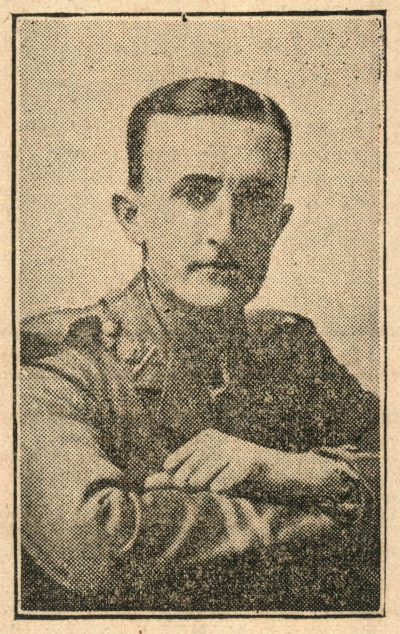 An interesting function of a private nature took place on Tuesday at the Sirocco Engineering. Works, when a tablet in memory of the late Captain J. S. Davidson, director and general manager of Davidson & Co. Ltd., was unveiled in the presence of the workers. Captain ‘Davidson was the only surviving son of Mr. S.C. Davidson, founder, and managing director of the company. When the Ulster Division was formed in September, 1914, Captain Davidson, who had been an active and energetic member of the 1st Battalion North Down Regiment, U.V.F., was amongst the first to offer his services, and was given a commission in the 13th Batt. Royal Irish Rifles (1st County Down Volunteers.) His knowledge of practical engineering was speedily discovered, and he was transferred to the Machine-Gun Section, subsequently being appointed to the position of Brigade Machine-Gun Officer, in which capacity he was serving in charge of the Machine-Gun Company at the time of his heroic death on the terrible 1st of July. 1916, when on the shell-torn slopes of Thiepval he passed to his eternal reward, at the early age of thirty-eight.
An interesting function of a private nature took place on Tuesday at the Sirocco Engineering. Works, when a tablet in memory of the late Captain J. S. Davidson, director and general manager of Davidson & Co. Ltd., was unveiled in the presence of the workers. Captain ‘Davidson was the only surviving son of Mr. S.C. Davidson, founder, and managing director of the company. When the Ulster Division was formed in September, 1914, Captain Davidson, who had been an active and energetic member of the 1st Battalion North Down Regiment, U.V.F., was amongst the first to offer his services, and was given a commission in the 13th Batt. Royal Irish Rifles (1st County Down Volunteers.) His knowledge of practical engineering was speedily discovered, and he was transferred to the Machine-Gun Section, subsequently being appointed to the position of Brigade Machine-Gun Officer, in which capacity he was serving in charge of the Machine-Gun Company at the time of his heroic death on the terrible 1st of July. 1916, when on the shell-torn slopes of Thiepval he passed to his eternal reward, at the early age of thirty-eight.
Mr. A. Agar, as chairman of the Memorial Fund, in opening the proceedings, said:—The Captain J. S. Davidson Memorial Fund was conceived as the result of a general desire on the part of the employees and business associates of the firm to put in a permanent form their deep appreciation of his high qualities, together with the heroic conditions under which he met his death. In honouring him, they honoured themselves in the fact he was one of them. As an employer and associate who was straight, just, and generous, and as soldier he met his death as only a brave man can. He had left behind him a noble example and the tablet which was to be unveiled that day would be a reminder to all who passed in and out of those gates, that while he him-self was dead his example still lives. (Applause.)
Mr. H. T. Coulter (treasurer of the fund) said the spontaneity and sympathetic enthusiasm which applied to the Captain Davidson Memorial Fund was evidenced by the fact that it was voluntarily participated in, not only by the general body of employees at the works, but also by their different branches and agencies at home and abroad, as well as by some of the business associates of the concern throughout the world. Their Australian and American friends sent very generous contributions, and the total amount of the fund, including bank interest, represented in round figures some £550. (Applause.) Each section of the subscribers was represented on the committee, and the final allocation of the fund was as follows:-
A donation of £200 to the Ulster Women and Children’s Hospital, Templemore Avenue, to name two cots the Captain J. S. Davidson Cots. A donation of £100 to the U.V.F. Hospital for the equipment of a gymnasium in connection with the orthopaedic branch, Captain Davidson’s name being identified therewith.
THE MEMORIAL EXHIBITION
The founding of an engineering scholarship at the Belfast Technical institute, to be known as the “Captain J. S. Davidson Memorial Exhibition,” under which a gold medal will be awarded annually, together with a cash prize, the total value of the exhibition each year being £10, and applying in particular to the third year course in mechanical engineering. The gifts to the two hospitals had already been made, and commemorative tablets have in each case been installed by the hospital authorities, while, as regards the Engineering Scholarship, an investment was being arranged in the names of trustees in £200 War Loan stock, the income from which will furnish the necessary funds for the exhibition. The three trustees would be the chairman of the Technical Instruction Committee of the Belfast Corporation, the Principal of the Technical Institute, and a director of Davidson & Co., Ltd. The Institute authorities had already issued a prospectus giving details of the exhibition, which would be open for competition as from that year. The balance of the fund had been utilised for providing the memorial tablet, which was to be unveiled that day. It was felt by all of them that, in addition to the philanthropic and educational purposes to which the fund had been devoted, it was desirable to have some permanent memento of Captain Davidson associated with the works there seeing that his entire business career was spent in the concern, and no more appropriate site could have been chosen for the tablet than that on which it was now erected, as not only was this Captain Davidson’s own office in the years of his young manhood, but in his boyhood’s days he (Mr. Coulter) remembered that he and other members of his family received technical education from a private tutor in a small classroom of a building that stood on the same spot. The crest of the Davidson family (which is embodied in the tablet) shows the head of a phoenix, and a free translation of the family motto is “Virtue rises from ashes.” May the virtues of him who has fallen on the field of honour ever inspire us He is not dead who lives in the hearts of those he leaves behind. (Applause.)
The Chairman then called upon Mr. T. Bailie, who has been in the employment of the firm for 37 years, to address the meeting. Mr. Bailie said—In the awful crisis through which our nation is now passing one cannot help realising that, next to the protection of Providence, the barrier interposed between us and disaster is the bodies of brave men. Without them our Navy would be useless, our artillery silent, our machine-guns only so much scrap iron, and so we honour our brave defenders, and truly they are worthy of all the honour we can give them, for since the world began there hath not been done such deeds of bravery as our gallant soldiers and sailors have done and are doing by land and sea.
DAY OF SORROW AND GLORY
But of all these heroic deeds, the one which most appeals to the mind and heart of the people of Ulster was on that memorable Morn at Thiepval, 1st July, 1916, when our brave boys covered themselves with glory. But, alas, at what a cost! All over the hills and valleys of our fair province there was sorrow and sighing for the loved ones who were not. With all these we deeply sympathise, and the names and records of their fallen sons will never be forgotten. But we are met here to-day to pay tribute to the memory of Captain, J. S. Davidson, who was one of that immortal band who counted not their lives dear unto them, if so be they might help to carry the old flag to victory. Quiet, unassuming, and courteous in his manner and disposition, he won not only the respect but the deep affection of all with whom he came into contact. He had the highest principle and a strict sense of duty, and it was certain that no danger would daunt him, and no difficulties deter him from doing what he believed was right. This did not only apply to his more mature years, for I knew him from childhood; his whole life was consistent, his character clear as crystal and his honour true as steel. Such was the man, his life, and his death, and now that he has gone, it is most fitting that you and we, among whom he went in and out daily, should have decided to keep him in remembrance, not only by the beneficent schemes of which you have already been told, but also by the tablet, which is now made public and dedicated as a memorial to him. May it be a daily reminder to us and to those who come after us to follow those high ideals to which he was so devoted, and for the defence of which he gave so much, “for greater love than this hath no man that he lay down his life for his friends.” (Applause.)

The chairman then called upon Captain G. W. Matthew, a director of the firm, who was with Captain J. S. Davidson on the 1st July, 1916, at Thiepval, to unveil the tablet. This having been done, amid cheers, Mr. S. C. Davidson, managing director of the company, in accepting the tablet, said Mr. Chairman and fellow-workers, on behalf of this firm, and also on behalf of all the members of my family, I most gratefully accept this beautiful bronze tablet in memory of my only son, who patriotically gave his life in defence of the constitutional freedom and liberties not only of our own country, but also of the greater part of the whole world, against the degrading tyranny of German military autocracy. I esteem this memorial tablet, and the endowments to which the treasurer of your ‘committee has referred, as a far higher tribute to my son’s memory than any posthumous honour which the Government might have awarded him, because such honours are usually in recognition of only some single act of bravery, or merit, whereas the memorial which you have so generously contributed is based upon your appreciation of his personality and character, since he was, as a boy, serving his apprenticeship here amongst you. Your committee kindly left to myself the selection of the position in which the tablet is placed, and my reasons for choosing for it the central pier between the windows of what was my son’s office are that, after the war is ended, it is my intention to put up a roll of honour tablet on each of the adjoining piers, one of which will give the name of every man who joined the colours from these works, and also from our home and foreign branches, as well as from my own home (in all about 170 men), and the other tablet the names of those who have fallen or been wounded in the holy cause for which we and our Allies are fighting in this terrible war, the end of which, unfortunately, does not yet seem to be in sight.
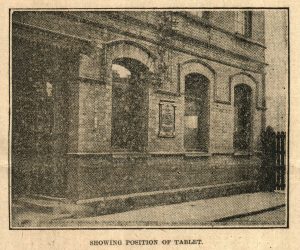 Mr. G. Crawford proposed a vote of thanks to the committee of the fund for the manner in which they carried out their duties. They had not only made it a financial success, but had administered the fund to the entire approval of the subscribers. An endowment to two hospitals, an engineering scholarship, and finally this tablet would each in its own way keep green the memory of Captain J.S. Davidson, when those who knew him personally and cherished his memory were no longer here.
Mr. G. Crawford proposed a vote of thanks to the committee of the fund for the manner in which they carried out their duties. They had not only made it a financial success, but had administered the fund to the entire approval of the subscribers. An endowment to two hospitals, an engineering scholarship, and finally this tablet would each in its own way keep green the memory of Captain J.S. Davidson, when those who knew him personally and cherished his memory were no longer here.
Mr. J. McDonald, in seconding the motion, said no permanent or other form of memorial could adequately commemorate the courage, gallantry, and resourcefulness displayed by Captain J. S. Davidson on that memorable day for the Ulster Division at ThiepvaI on 1st July, 1916, a day indelible in the memory of us all.
The motion was passed by acclamation. Mr. A. Brown hamming acknowledged the vote of thanks on behalf of the committee, the proceedings terminated.

